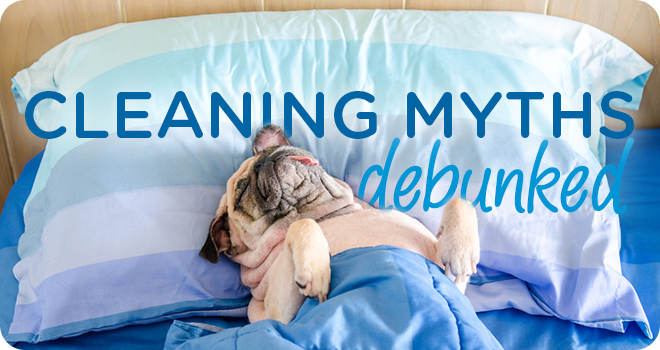
MYTH #1 Regular pillow cases keep pillows clean.
FALSE Only if you like wasting your money and sneezing! While a regular linen case offers some protection, plenty of perspiration, body oils, and dead skin cells still pass through and get absorbed by the pillow. Not only does that makes the pillow look dirty, it feeds allergy-triggering dust mites and mold, and slowly destroys the fiber filling, shortening pillow lifespan. Goose down and other natural-fill pillows are even more sensitive to neglect than synthetics, so investing in waterproof, hypoallergenic pillow protectors is a must both to extend pillow life and to save on tissues.
MYTH #2 You only need to wash pillows when they look bad!
FALSE Most pillows respond poorly to rugged treatment, becoming flat and mangled when washed in hot water or using heavy-duty cleaning cycles. The solution is to wash when soil levels are still low and easy to remove with only warm water on a delicate cycle. Frequent washing is even more important for hand-wash-only pillows. Even with an extra protective case, pillows should be washed at least every six months and more frequently if you’re a person who perspires heavily, drools, or suffers from allergies. Pillow covers should be washed at least monthly and regular linen cases weekly with the sheets.
MYTH #3 Use bleach to whiten and kill germs in dingy pillows.
FALSE Only if you like bright-white destroyed pillows! A powerful whitener and disinfectant, bleach degrades delicate fiber and down pillow fills. It also weakens the outer fabric of a pillow, making it prone to shredding and tearing. Again, better to wash pillows more frequently with milder products than trying to rescue with shock treatments. If you need to whiten, use a detergent booster such as OxiClean or Borax, which produce excellent results without all the damage. Using either solution to presoak prior to laundering on a delicate cycle will easily restore most pillows to a pleasingly pearly appearance.
MYTH #4 Use fabric softener to make pillows softer.
FALSE Fabric softener, while awesome for making towels and sheets feel snuggly soft, makes pillow problems worse. Oils and polymers in the softener cling to and gum up filling fibers, making them mat and clump. To picture the effect on down pillows, think of all those sad pictures of ducks after oil spills. To make pillows soft and fluffy, simply toss them into the dryer with dryer balls (or even old tennis balls) for at least an hour on a medium-to-low setting. Be sure the pillows are thoroughly dried before removing, as any remaining moisture will feed and restore the mold and dust mites you just finished washing away!
MYTH #5 Washed pillows get lumpy, so it’s best to just use them until dirty, then replace!
FALSE Like most things in life, you get what you pay for. It’s better to invest in quality that lasts rather than cheap junk you need to replace repeatedly — we’re glaring at you $5 department-store pillows! As a rule, the higher the quality of a washable pillow, the better it will retain its fluff over repeated washings. If you have neck and shoulder issues that cause you to choose essentially non-washable memory foam or gel pillows, be sure to invest also in high-quality covers and wash both the covers and pillow cases religiously to obtain the longest possible pillow lifespan.

